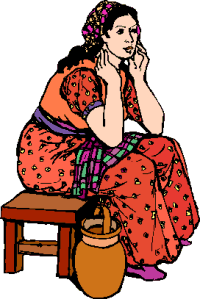Readings
- Textbook, The Ordination of Women, etc., chapter 17, on
‘The Reality of Women Deacons’, pages 147-155.
- NO WOMEN IN HOLY ORDERS?
The Women Deacons of the Early Church, by John Wijngaards,
Canterbury Press 2002, ISBN:1-85311-507-X.
Exercise 1
- Were you aware of the solemn way in which women deacons were
ordained?
- The word ‘sacrament’ first used by Augustine, only
became a common theological term in the Middle Ages. Does this prove the
Church’s ordination before that time were not
‘sacramental’?
|
Explaining the question
before us
The ordination of women deacons during the first millennium
of the Church in its eastern, Greek-speaking part, was clearly a real,
sacramental ordination, equal to the ordination of male
deacons.
The ordination
ceremony
The ‘sacramental’ nature of their ordination follows
from the following facts:
- In the ordination rituals, both the ordination of a deacon and
of a deaconess is called cheirotonia, i.e. Greek for ‘imposition of
hands’, ‘ordination’.
- Both the male and the female deacon are ordained by the
Bishop.
- Before the ordination of both the male and female deacon the
Bishop publicly declares his intention of ordaining the ordinand deacon
in the ‘Divine Grace’ statement, as in all major holy orders.
- The ordination of both male and female deacon takes places in
the sanctuary before the altar, during the liturgy of the Eucharist and at a
very solemn moment, namely after the sacred Anaphora. So-called minor orders,
such as the lectorate and subdiaconate, are imparted by a simple imposition of
hands outside the sanctuary and not during the Eucharist.
- The Bishop ordains both by imposing his hands on the head of
the person to be ordained (the materia of the sacrament of orders).
- The Bishop invokes the Holy Spirit both on the male and the
female deacon with the same invocatory prayer, ‘Receive the Holy Spirit .
. . ’, (the forma of the sacrament of orders).
- Both the man and the woman selected for the diaconate stand
waiting on the steps in front of the holy doors leading into the sanctuary, and
are then conducted to the sacred altar and there ordained by the Bishop.
- The Bishop speaks two prayers of ordination, characteristic for
higher orders.
- For both the male and the female deacon, the Bishop speaks the
ekphonese (=soft-spoken) prayer ‘The divine Grace . . . .’,
something that is characteristic of the higher orders.
- Because of the presence of the rest of the clergy and the
people, the ordination has a public character.
- Both the male and the female deacon receive the stole as
a sign of their ecclesiastical rank.
- Both the deacon and deaconess receive the chalice for
communion, which the deaconess returns personally to the altar.
The actual text of the ordination rituals for women deacons has
been preserved in a few precious manuscripts:
There are some small
differences
which do not affect the essence of the ordination.
The sacramental character of the ordination of women deacons is
indisputable. Both the matter and form of the ordination were
identical for men and women, and expressed the bishop's intention to ordain
true ministers.
“If anyone says that, through sacred ordination, the Holy
Spirit is not given, and that therefore the Bishop says in vain: ‘Receive
the Holy Spirit’, or that through this ordination the character [of holy
orders] is not imprinted . . . , let him be anathema.”
The Council
of Trent, Canon 4. Denzinger no 964. |
Online readings
Exercise 2
- Among first-millennium deacons, the men assisted at the altar,
the women usually did not. Does this prove that their ordination was
different?
- A deacon’s main task, whether man or woman, was to assist
in baptisms. Why was the ministry of baptism so important to people in the
Early Church?
For assessment in this course, send
an email to Jos Rickman at the address given below. Mention (i) your name, (ii)
your registration number, (iii) your email and (iv) the name of this course.
And (v) attach a short document containing your answers to the exercises of
this lesson.

|
|
The judgement of
experts
 While some
traditional
theologians still deny the sacramentality of the ordination given to women
deacons, more and more experts concur in stating that the ordination of women
deacons undoubtedly belonged to the sacrament of order: While some
traditional
theologians still deny the sacramentality of the ordination given to women
deacons, more and more experts concur in stating that the ordination of women
deacons undoubtedly belonged to the sacrament of order:
- A. Ludwig, ‘Weibliche Kleriker in der altchristlichen und
frühmittelalterlichen Kirche’, in Theologisch-praktische
Monatschrift 20 (1910) pp. 548-557, 609-617; 21 (1911) pp. 141-149.
- “The cheirotonia of the deaconess with its
ceremonies is in form parallel to that of the deacon. All consecration
formulas, from those of the Apostolic Constitutions and the Testamentum to
those of the Monophysites and the Nestorians and that handed down by Matthaeus
Blastares, bear witness to this fact." A. Kalsbach, Die altkirchliche
Einrichtung der Diakonissen bis zu ihrem Erlöschen, Freiburg, 1926, p.
109.
- “The ordination of deaconesses is an exceptional case in
the history of the Church. It belonged , without any doubt, to the higher
orders.” Evangelos Theodorou, ‘Die Weihe, Die Segnung der
Diakoninnen’ (in modern Greek), Theologia 25 (1954) pp. 430 - 469.
“The ordination of deaconesses possessed an absolute morphological
sameness to the cheirotonia of the higher clergy”; Evangelos Theodorou,
‘Das Ambt der Diakoninnen in der kirchlichen Tradition. Ein orthodoxer
Beitrag zum Problem der Frauenordination’, US 33 (1978) pp. 162-172.
- J. Funk, “Klerikale Frauen?” in
Österreichisches Archiv für Kirchenrecht 14 (1963) pp.
274-280.
- L. Zscharnack, Der Dienst der Frau in den ersten
Jahrhunderten der christlichen Kirche, Göttingen, 1902, pp. 130ff.
- J. Daniélou, “Le ministère des femmes dans
l’Église ancienne, ” in La Maison-Dieu 61 (1960) pp. 70
- 96.
- “To push the argument against the sacramentality of the
ordination of deaconesses too far would be in fact to deny the sacramentality
of the ordination of deacons. ” Ch. R. Meyer, ‘Ordained Women in the
Early Church’, in The Catholic Citizen 53 (1967) p.118.
- Cipriano Vagaggini, ‘L'Ordinazione delle diaconesse nella
traditione greca e byzantina’, Oriente Christiano Patristico
(OrChrP) 40 (1974) pp. 145 - 189.
- Roger Gryson, Le ministère des Femmes dans
l'Église ancienne, Gembloux, Duculot 1972; ‘L’Ordination
des Diaconesses d'après les Constitutions apostoliques’, MSR 31
(1974) pp. 41-45.
- Herbert Vorgrimler, Sacramental Theology, The Liturgical
Press, Minnesota 1992, pp.272-273: “The possibility of ordaining women as
deacons is quite another matter. There was such an ordination in the early days
of the Church . . . The question whether their ordination is sacramental could
not be asked before the reflections on sacramental theology in high
Scholastics. In the Byzantine liturgy, it has all the characteristics of a
major ordination.”
- Andreas Christof Lochmann, Studien zum Diakonat der
Frau, Siegen 1996.
- Walter Gross, Frauen Ordination. Stand der Diskussion in der
katholischen Kirche, München 1996.
- A. Jensen, ‘Das Amt der Diakonin in der kirchlichen
Tradition des ersten Jahrtausend’, in Diakonat. Ein Amt für Frauen
in der Kirche -- Ein frauengerechtes Amt?, ed. P. Hünermann et al.,
Schwabenverlag, Ostfildern 1997, pp. 53-77.
- P.Hünermann, ‘Theologische Argumente für die
Diakonatsweihe von Frauen’, in Diakonat. Ein Amt etc., pp.
98-128.
- B.J.Hilberath, ‘Das Amt der Diakonin: ein sakramentales
Amt? Ein Zugang von der Gemeinde her’, in Diakonat. Ein Amt etc.,
pp. 212-218.
- D.Sattler, ‘Zur Sakramentalität des Diakonats der
Frau’, in Diakonat. Ein Amt etc., pp. 219-224.
|











